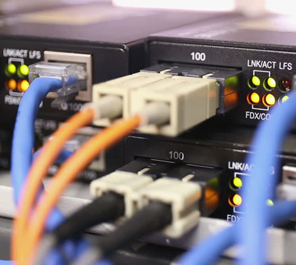A fiber optic media converter is a popular networking device that helps connect fiber optic cables with copper cables and other non-fiber devices within the network. This article will provide some knowledge about media converters.
What is Fiber Optic Media Converter?
The fiber optic media converter, also known as an Ethernet media converter, is a device used to convert Ethernet electric signals into optical signals or vice-versa and transmit optical signals over multi-mode fiber or single-mode fiber.
Types of Fiber Optic Media Converters
● By Functions
Managed and Unmanaged Fiber Optic Media Converter
Managed fiber optic media converter has the functions of networking monitoring, fault detection, and remote management. It enables network administrators to control the data, bandwidth, and traffic. The unmanaged fiber optic media converter has plug-and-play and is easy to install. It allows simple communication with other devices but does not have monitoring and management functions.
PoE Fiber Optic Media Converter
Power over Ethernet (PoE) fiber optic media converter uses the Ethernet standard and supplies power and data over a single cable. It is used to power devices such as IP phones, IP cameras, and wireless access points.
Stand-Alone and Chassis-Based Fiber Optic Media Converter
Stand-alone fiber optic media converter turns an Ethernet connection into fiber cabling. It has a small size, easy to use and deploy, low cost, and supports ultra-fast long-distance connections. Stand-alone fiber optic media converter is suitable for applications in environments with limited space such as telecommunication cabinets or a distribution box. Chassis-based fiber optic media converter includes several independent media converters and a chassis capable of housing up to 16 media converters. It is convenient for management when many media converters are needed in a large network.

Commercial and Industrial Fiber Optic Media Converter
A commercial fiber optic media converter is designed for office and data center environments. It has a single power input and low power consumption. Industrial fiber optic media converter is designed for harsh environment applications. It has low power consumption, industrial temperature -40~85℃, high reliability, and high stability.
Standard and Mini Fiber Optic Media Converter
A standard fiber optic media converter is designed without a web interface. It is used in enterprise data networking and metropolitan area networks. Mini-fiber optic media converter has DIP (dual in-line package) switch functions and is small in size. It is used in large network environments.
● By Transmission Media
Copper-to-Fiber Media Converter
Copper-to-fiber media converter enables connections of copper-based Ethernet devices over extended network distances via a fiber optic link, which protects data from noise and interference.
Fiber-to-Fiber Media Converter
Fiber-to-fiber media converter provides connectivity between multi-mode and single-mode fiber, dual fiber, and single fiber and supports wavelength conversion.
Applications
Fiber optic media converter is used in data transmission networks, access networks, remote surveillance, video security, IP phones, LAN/MAN, data centers, oil and gas, industrial automation, transportation, healthcare, government, etc.
Conclusion
A fiber media converter serves as a cost-effective solution for the connection with both copper cable and fiber optic cable in a network. It can extend transmission distances and is flexible and easy to use. Sun Telecom specializes in providing one-stop total fiber optic solutions for all fiber optic application industries worldwide. Contact us if any needs.


 Position :
Home>
News & Tutorial
>Products
Position :
Home>
News & Tutorial
>Products









 Position :
Home
>Products
Position :
Home
>Products







 ics@suntelecom.cn
ics@suntelecom.cn  +86 18964888554
+86 18964888554 Building No.145, Lane 666 Xianing Road, Jinshan Industrial Zone, Shanghai 201506, China
Building No.145, Lane 666 Xianing Road, Jinshan Industrial Zone, Shanghai 201506, China